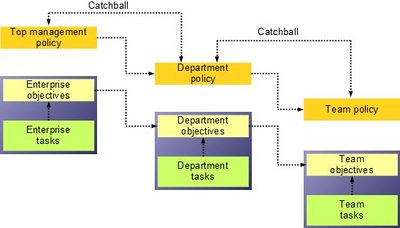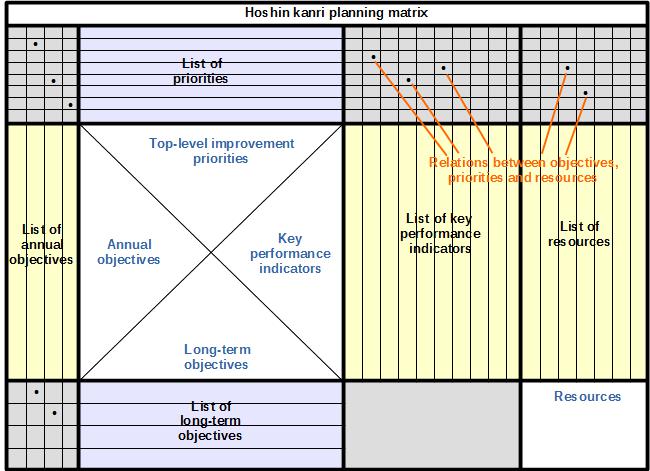Hoshin kanri
| Hoshin kanri |
|---|
| See also |
Hoshin kanri is an system approach to planning, that fosters continuous improvement. It involves every employee into processes of strategic management. It's a Japanese version of management by objectives (MBO).
Hoshin kanri begins with a strategic plan developed by top management. Then mid-level managers develop tactical objectives on departmental level, that allow to achieve strategic objectives. On the floor level, team leaders an managers work out the operational objectives and details. The important method is "catchball" - extensive communication between management levels in order to keep high level of compatibility between objectives. Results are being monitored weekly or monthly and appropriate adjustments are made if necessary[1].
Hoshin principles
- Measure your organization. Measurement gives management a clear understanding on how the organization is performing.
- Get everyone focused. Setting the objectives, communicating them and setting owners improves level of goal achievement.
- Use organization's capacity. Full capacity of the organization towards objectives achievement is unknown until top management involves all employees into strategic planning.
- Set priorities. Every organization has limited resources. They should be used efficiently and effectively.
- Involve everyone. Including every employee into the process creates a new dynamic and enables faster growth[2].
7 steps of Hoshin kanri
Step 1. Establish the vision
The vision of the organization is a preliminary step towards Hoshing kanri implementation. If the top management doesn't know the vision and mission of the organization it is unable to develop a strategic plan[3].
Step 2. Develop long-term objectives
Long-term objectives show the way to managers and employees. In 60s and 70s it wasn't unusual to create objectives for next 10, 15, 20 years. Nowadays we live in turbulent world. Planning for 3-5 years is regard as long-term. Some even say that it is impossible to plan, and they suggest emergent strategies.
Step 3. Develop annual objectives
Long-term objectives should be sliced into 1-year objectives. Depending on the type of the objective, it can be possible to achieve 1-2 long-term objectives or rather focus on achieving 20-30% of every long-term objective.
Step 4. Deploy objectives
The strategic plan should be deployed on departmental level and lower levels. The objectives should be cascaded until reaching teams or workplaces. At each level objectives are more detailed. Catchball method allows keeping compatibility.
Step 5. Implement objectives
The actions required to achieve objectives are planned and then executed. Effects are monitored.
Step 6. Review objectives
The reviews should be taken monthly. Each variation from the planned KPIs and objectives should be analysed and appropriate corrective measures should be taken. Monthly review allows to keep involvement and foster culture of accountability.
Step 7. Annual review
Each annual cycle is ended with annual review. The review enables top management to improve vision and long-term objectives. It's also important input into next year cycle of Hoshin kanri.
Hoshin methods
Visionary strategic planning
As every company has limited resources, managers shouldn't set too many objectives. Five objectives or less are a rule of thumb in Hoshin kanri. Reducing number of goals forces managers to focus on the most important ones. It is important to not only achieve goals, but also to choose goals that are important.
Consensus (catchball)
Hoshin kanri is based on consensus. Top managers are responsible for strategic planning, but the should consult plans with middle managers. The same way - middle managers consult with lower level managers and team leaders. Consultation allows:
- additional perspective
- feedback on capability of enterprise
- removal of objectives that are not possible to achieve
- create a shared responsibility
- involve employees on every level into strategic planning
Measuring progress
Key performance indicators (KPI) are the method of monitoring progress. It is important to choose KPIs wisely, as they sometimes become ghost objectives - workers may focus on KPI value, not the goal showing larger perspective. Fulfilment of KPI should mean simultaneously fulfilment of the objective.
Goal owners
Every goal should have an owner, who is responsible for monitoring actions that lead towards the goal. He is a facilitator and a coach.
Hoshin planning matrix
Hoshin planning matrix is an important tool that allows to monitor planning and achievement of objectives. It's should be available to all employees involved in Hoshin kanri. It is important to state that plans flow from two sources: long-term planning and review of annual objectives.
Advantages of Hoshin kanri
Hoshin kanri is a system approach to planning that fosters continuous improvement. The following are some of the advantages of using Hoshin kanri:
- It encourages employee involvement in the strategic management process. By involving employees in the decision-making process, it helps to ensure that their ideas and feedback are heard, and that the goals and objectives of the organization are aligned with those of its employees.
- It promotes clear communication of goals and objectives. By providing a framework for setting and communicating goals, Hoshin kanri helps to ensure that everyone in the organization is on the same page and working toward the same goal.
- It encourages collaboration and teamwork. By creating a system in which everyone is working together toward a common goal, Hoshin kanri encourages collaboration and teamwork, which can help to foster a better workplace culture.
- It supports continuous improvement. By promoting a process of continuous improvement, Hoshin kanri ensures that the organization is always striving to do better and striving to reach higher goals.
Limitations of Hoshin kanri
Hoshin kanri is a system approach to planning that involves every employee into processes of strategic management. However, there are certain limitations to this approach:
- Implementation of Hoshin kanri is complex and requires a large organizational commitment.
- It may be difficult to ensure that all employees understand the approach and the goals of the organization.
- Continuous improvement processes require reliable data, which may be difficult to collect and analyze.
- It may be difficult to ensure that all employees are adequately trained to use the system correctly.
- The approach may be too rigid for certain organizations, not allowing for enough flexibility.
- It may be difficult to ensure that all employees are motivated to reach the goals set by the organization.
Hoshin kanri is an system approach to planning, that fosters continuous improvement. Here are some other approaches related to Hoshin kanri:
- Kaizen - Kaizen is a Japanese term that means "continuous improvement". It is based on the idea that small, incremental changes can have a large impact over time.
- Total Quality Management (TQM) - TQM is a management approach which focuses on the continuous improvement of the quality of products and services. It emphasizes the importance of customer satisfaction and emphasizes on prevention rather than detection of defects.
- Six Sigma - Six Sigma is a business management strategy that seeks to improve the quality of processes by minimizing variation and eliminating defects.
- Lean Manufacturing - Lean manufacturing is a production system that emphasizes the elimination of waste and the continuous improvement of processes. It focuses on maximizing customer value while minimizing waste.
In conclusion, Hoshin kanri is an system approach to planning and there are other approaches related to Hoshin kanri such as Kaizen, Total Quality Management, Six Sigma and Lean Manufacturing. All of these approaches emphasize continuous improvement and the importance of customer satisfaction.
References
- Witcher B.J., Butterworth R. (2001) Hoshin Kanri: Policy Management In Japanese-Owned UK Subsidiaries, Journal of Management Studies, 38(5)
- Tennant Ch., Roberts P. (2001) Hoshin Kanri: Implementing the Catchball Process Long Range Planning, 34(3)
- Hutchins D. (2008) Hoshin Kanri. The Strategic Approach to Continuous Improvement, Burlington VT:Gower
Author: Slawomir Wawak

